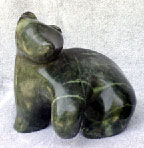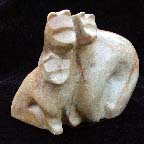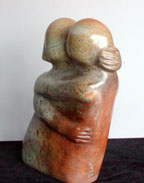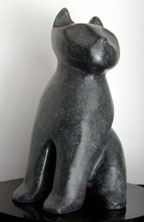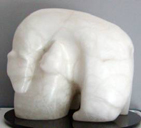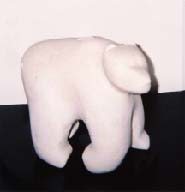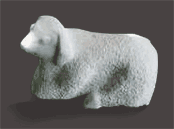|
Geer's Creations - About Stone |
||
|
|
|
Most of my sculpture is carved from Soapstone or Alabaster. I also love to carve Carrara Marble. Soapstone
contains talc, which creates the slippery feel that gives it its
name. It varies greatly in hardness and density.
One drawback to the soapstones is that metals can scratch them. The softest Brazilian that I use can be scratched by jewelry or a button, so you must be careful when handling it. I seal the surface of all my work with Johnson's Paste Wax. If there is a minor scratch you may be able to simply rub it out with a soft cloth. Deeper scratches may require wet sanding and polishing.
Kisii Stone is the newest soapstone that I use. This beautiful stone is found near the village of Kisii in the Tabaka Hills of Western Kenya. It ranges in color from deep gold to rich burgundy, pale pink to mauve and black to creamy white. Each piece has it's own unique combination of color and patterns. The various colorations and patterns running through it are formed as different minerals (particularly iron) leach through the stone as it sits underground. You will often see dancers and family groups made by native carvers from the Kisii tribe of Kenya for sale in African gift shops.
Alabaster
is a highly compacted form of gypsum. It is available in a wide
range of colors. I have three favorites:
Italian Crystal Alabaster is a beautiful translucent white. It has fine delicate inclusions that can be mistaken for cracks, but these do not affect the integrity of the stone. It is found in caves in Northern Italy, often underwater. It comes from the same region as Carrara Marble. Salmon Alabaster is also a new stone for me this year. It comes from Utah in four-inch wide strips. Designs are limited, but the beautiful color inspires creative ideas.
Carrara
Marble is the stone that Michelangelo used for
his greatest creations, like David and the Pieta. I bought my
supply while staying in Pietrasante, from the same quarry in Carrara
where he got his stone. It is only a few kilometers from Artspace
where my daughter Criis and I studied marble carving in 1997.
Marble
is the hardest of the stones I use. It takes about five times
as long to work as soapstone or alabaster, but is much more impervious
to the elements. The beautiful white gives my sculptures a classic
look. J.
Gail Geer |
||||||||||||||||||||||||||||||||||||||||||||
|
|
||
|
Images and text ©2001-2007 Geer's Creations |
